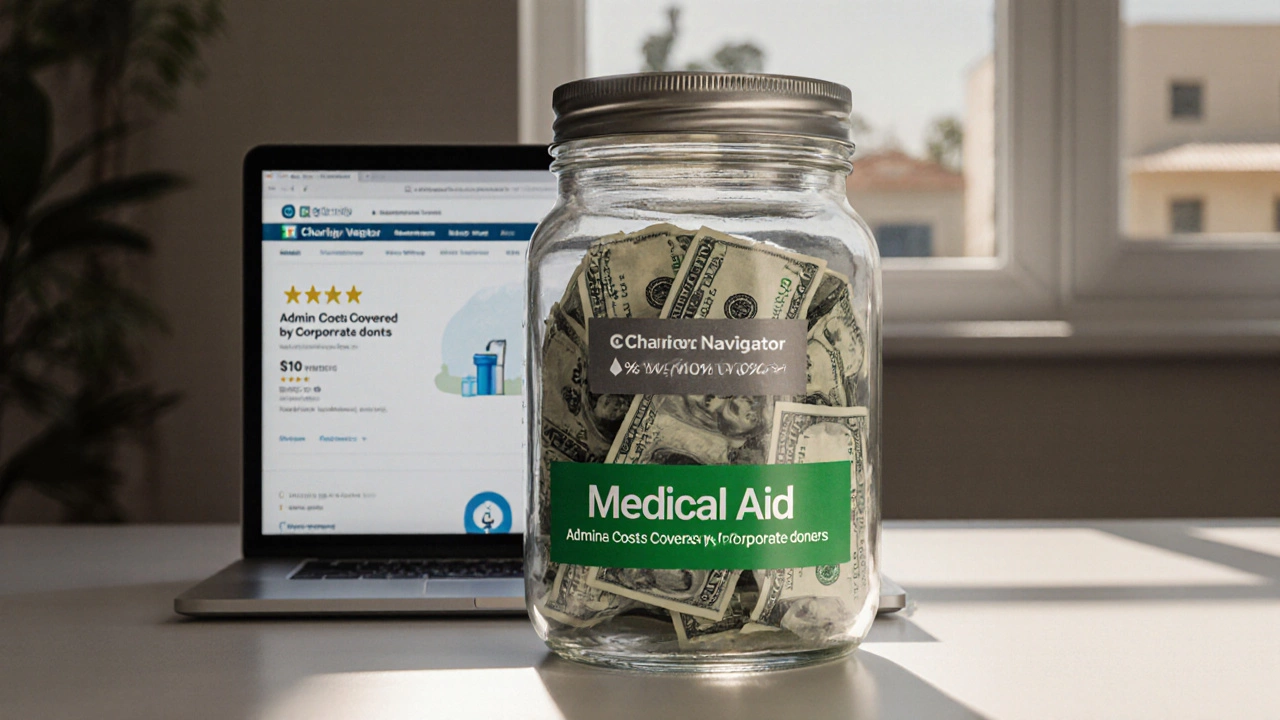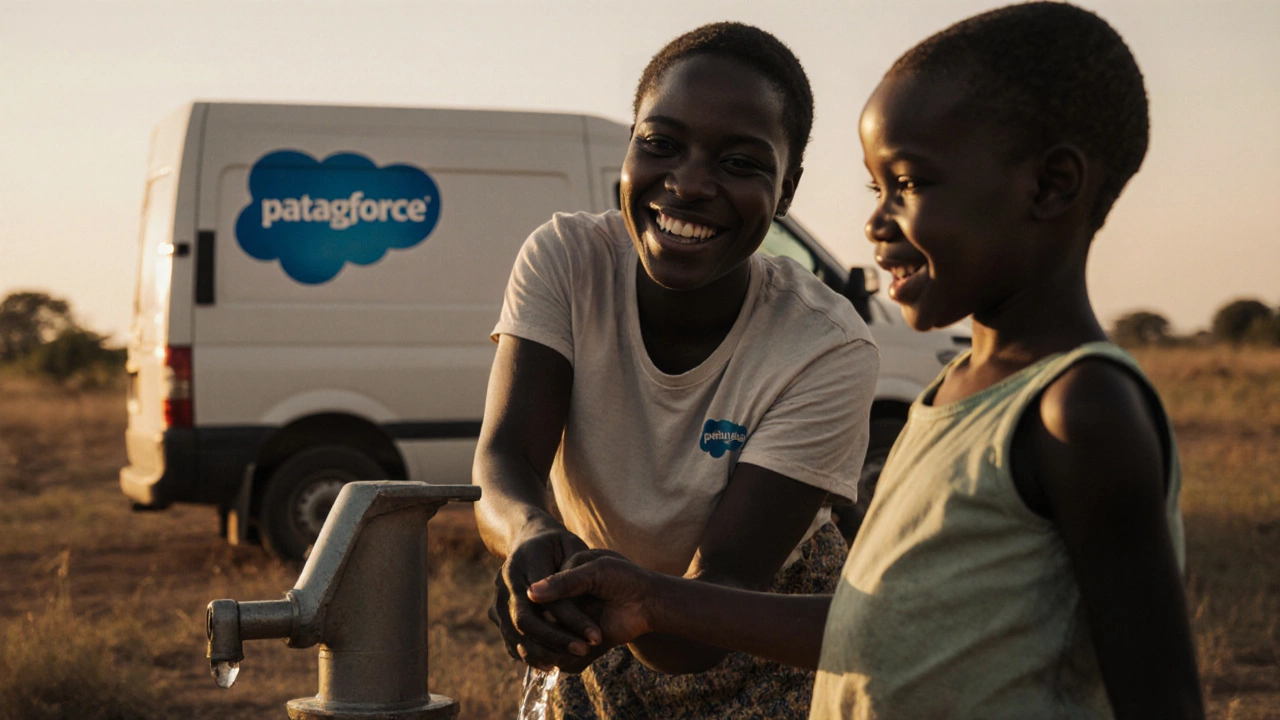Which Charities Use 100% of Donations? Real Examples and How to Spot Them
 Nov, 20 2025
Nov, 20 2025
Charity Impact Calculator
Calculate Your Donation Impact
Find out how much of your donation goes directly to program services versus overhead costs.
How to Interpret Results
Program spending percentage shows what portion of donations goes directly to services, not overhead. Most reputable charities spend 75-85% on programs.
According to the article: "Charities spending 75% or more on programs is considered efficient."
Overhead includes administrative costs, fundraising, and staff salaries needed for operations.
Key Benchmark
Industry benchmark for efficient charities
Your Donation Impact
Tip: For every $100 donated to a charity with 85% program spending, $85 goes to services while $15 covers essential overhead.
Red Flag: If overhead exceeds 20%, it may indicate inefficient fundraising or administration.
When you give money to a charity, you want to know it’s actually helping people-not lining the pockets of executives or paying for glossy brochures. That’s why so many people ask: Which charities use 100% of donations? The short answer? Very few do. But that doesn’t mean your money can’t go further than you think.
Why 100% is Almost Impossible
Here’s the truth: no legitimate charity can operate with zero overhead. Even the smallest organization needs to pay for things like bank fees, website hosting, accounting software, and staff who answer donor questions. If a charity claims 100% of donations go to programs, they’re likely hiding costs somewhere-maybe by paying staff through separate fundraising arms or using volunteers for everything, which isn’t sustainable.
The Better Business Bureau’s Wise Giving Alliance and Charity Navigator both say that a charity spending 75% or more on programs is considered efficient. That means up to 25% can go to administration and fundraising. That’s not waste-it’s infrastructure. Think of it like this: a bakery can’t bake bread without an oven, electricity, or someone to manage the register. Charities are the same.
What Actually Counts as "100%"
Some charities say they use 100% of donations because they cover operating costs separately. For example, a charity might have a parent organization or a group of donors who pay for overhead so every dollar from public donations goes directly to aid. This is legal and transparent-but it’s rare.
One real example is Direct Relief is a U.S.-based nonprofit that provides medical supplies to underserved communities worldwide. It receives funding from pharmaceutical companies and private donors specifically to cover administrative costs, so 100% of public donations go to medical aid. In 2023, they distributed over $1.2 billion in aid, with less than 4% spent on fundraising and administration combined.
Another is Project HOPE’s "100% for Patients" program, where corporate sponsors fund staff salaries and office expenses, allowing donor dollars to fund medical missions and supplies. Their 2024 financial report shows 91% of total expenses went to programs, with the rest covered by non-donation funding.
These aren’t gimmicks-they’re structured models built on trust and transparency. But they’re the exception, not the rule.
How to Find Truly Efficient Charities
You don’t need to find a charity that uses exactly 100%. You need to find one that uses your money wisely. Here’s how:
- Check their IRS Form 990. Every U.S. nonprofit files this. It’s public. Look at Line 17 (program services expenses) versus Line 20 (total expenses). If program expenses are above 75%, it’s solid.
- Use Charity Navigator or GuideStar. These sites rate charities on financial health and accountability. Look for 4-star ratings.
- Look for "donor-funded overhead" models. If a charity says, "Our overhead is covered by foundations," that’s a good sign. It means your donation isn’t paying for their rent.
- Avoid charities that spend more than 20% on fundraising. High fundraising costs often mean they’re chasing donations instead of delivering results.
- Read their annual report. Not the glossy one-look for the financial statements. If they’re buried or vague, walk away.
In Australia, you can check the Australian Charities and Not-for-profits Commission database. Every registered charity must file financials. Search by name and look at the "Financial Information" tab.

Charities That Come Close to 100%
These organizations consistently score above 90% program spending and are transparent about how they cover overhead:
- St. Jude Children’s Research Hospital (U.S.)-No family ever pays for treatment. Their overhead is covered by donors who fund operations separately. In 2023, 82% of expenses went to programs, but over $1.4 billion came from unrestricted donations that covered infrastructure.
- The Water Project (U.S.)-Focuses on clean water in Africa. 92% of donations went to programs in 2024. Their overhead is funded by corporate partners like Patagonia and Salesforce.
- GiveDirectly (U.S.)-Sends cash directly to people in extreme poverty. No middlemen. 90% of donations went to recipients in 2023. Their admin costs are low because they use mobile tech and minimal staff.
- Charity: Water (U.S.)-Famous for its "100% model," where donors fund overhead separately. In 2024, 80% of total expenses were program costs, but they raised $40 million from private donors to cover operations, meaning every public dollar went to water projects.
Notice a pattern? None of these charities actually spend 100% of every single donation on programs. But they make sure your donation isn’t paying for their office rent or marketing team. That’s the real win.
Red Flags That Mean Your Money Isn’t Going Far
Watch out for these warning signs:
- "100% of your donation goes to the cause"-but no explanation of how overhead is paid. That’s a trap.
- High-pressure phone calls or door-to-door canvassers. These cost a lot, and you’re paying for them.
- Charities with names that sound like big names but aren’t registered (e.g., "National Children’s Foundation"-there’s no such registered charity in the U.S. or Australia).
- Donations that go to "support services" or "general fund" with no breakdown.
- Charities that don’t publish financials online. If they won’t show you their books, they’re hiding something.
In 2023, the Australian Competition and Consumer Commission warned about charities using fake names and misleading claims. One group claimed to help homeless veterans but spent 85% on fundraising. They were shut down.
What You Can Do Right Now
You don’t need to find a perfect charity. You need to find a trustworthy one. Here’s your quick action plan:
- Find a charity you care about-say, animal shelters, clean water, or youth mentoring.
- Go to Charity Navigator (for U.S.) or the ACNC (for Australia) and search for them.
- Check their program spending percentage. If it’s 80% or higher, you’re good.
- Look for a line like: "Administrative costs covered by private donors." That’s your green flag.
- Set up a monthly donation. Consistent giving helps charities plan better and reduces fundraising costs over time.
And if you’re still unsure? Ask them. Send an email: "How much of my donation goes directly to programs, and how are overhead costs covered?" If they hesitate or give a vague answer, move on.

Why This Matters Beyond the Numbers
When you give to a charity that uses money wisely, you’re not just helping people-you’re rewarding transparency. You’re telling the nonprofit world: "We value accountability." That pushes more organizations to clean up their act.
It also means your $50 or $100 has more impact. A charity spending 85% on programs gets more meals to hungry families, more books to kids, more medicine to clinics than one spending 50% on ads and salaries.
And if you’re thinking about volunteering? The same rules apply. Look for organizations with clear leadership, documented outcomes, and real stories-not just emotional photos.
Final Thought: It’s Not About 100%. It’s About Trust.
You don’t need a charity that uses 100% of donations. You need one you can trust. The ones that publish their numbers, explain their costs, and prove their impact are the ones worth supporting. Don’t chase perfection. Chase honesty.
Do any charities really use 100% of donations?
No legitimate charity uses 100% of every donation for programs because all need some overhead to operate. But some charities cover administrative costs with separate funding-like corporate sponsors or private donors-so public donations go entirely to aid. Direct Relief and Charity: Water are examples of this model.
Is it bad if a charity spends money on staff?
Not at all. Skilled staff make charities more effective. A well-paid accountant ensures funds aren’t misused. A professional grant writer secures more funding. The key is whether staff costs are reasonable and aligned with results. A charity with 30% staff costs but 90% program spending is better than one with 10% staff but only 50% program spending.
How do I check a charity’s finances in Australia?
Go to the Australian Charities and Not-for-profits Commission (ACNC) website. Search the charity’s name, then click "Financial Information." You’ll see their annual report, income, expenses, and how much went to programs. All registered charities must file this.
Are charities with low overhead always better?
Not always. A charity with 95% program spending might be underfunded and struggling to grow. A charity with 80% program spending might have better systems, more staff, and greater long-term impact. Look at outcomes, not just numbers. Do they report measurable results? Do they share stories of real change?
Can I trust charities that use telemarketing?
Be cautious. Telemarketing is expensive-often costing 40-60 cents per dollar raised. That means for every $100 you give, $40-$60 might go to the call center, not the cause. Many reputable charities avoid it. If a charity relies on cold calls, ask how much they spend on fundraising and whether your donation is covering those costs.
Next Steps: How to Give Smarter
Start small. Pick one charity you believe in. Check their financials. If they’re transparent and efficient, set up a monthly gift-even $10. Consistent donations help them plan better and reduce the need for costly fundraising.
If you’re volunteering, join a charity that publishes impact reports. Ask to see their annual review. Talk to their staff. If they’re proud of their results and open about their challenges, you’ve found a good fit.
And remember: the best charity isn’t the one with the flashiest website or the loudest ad. It’s the one that gets things done-and lets you see how.